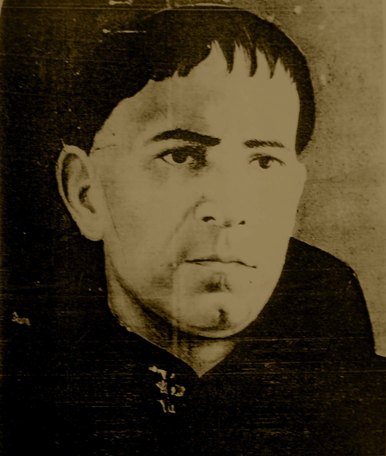
Father Mariano Granja
photo from Carlos Villariba’s collection
As Lucenahins, we’re all quite familiar with Granja St., and even with the panciteria that is situated along that street. But did you know that the name behind Granja St. was also the same person behind the name Lucena?
According to some historians, Lucena City got its name from Lucena, a town of the province of Andalucia in Spain, in honor of Father Mariano Granja who is believed to have been born there. But who is Father Mariano Granja and why is the name Lucena chosen in honor of him?
Rev. Father Mariano Granja, OFM, is a 31-year old Franciscan missionary who came here in the Philippines in the year 1872 where he was first assigned as Vicar to the Nuns of Sta. Clara. He also served as parish priest in Gumaca in 1874, and Tayabas in 1875.
He supported the principalia on their proposal for the establishment of a new town in Cotta, a barrio of Tayabas Province. A petition was made on January 15, 1879 for the creation of the new town which was endorsed by the Alcalde Mayor. The barrios that are to be included in the new town are Mayao, Gulang-gulang, Ibabang Dupay, Ilayang Dupay, Canlurang Iyam, Silangang Iyam, Ibabang Talim, Ilayang Talim, Bocohan, Ibabang Isabang, Canlurang Domoit, Silangang Domoit and Salinas.
This petition was then referred by the Governor General to the Council of Administration on April 17, 1879. After passing, it was forwarded to the Civil Administration on June 26, 1879. On the 5th of July of the same year, it was returned to the Alcalde Mayor for further evaluation of the barrios that will be included in the new town. The principalia and the parish priest held a hearing regarding this matter, and came up with a decision that the barrio of Salinas should stay within Sariaya’s jurisdiction. The results of the said hearing was submitted on July 5 and was revised by the Council of Administration on August 11. The revised proposal was then received by the Civil Administration on October 16 and finally on November 3, 1879, a royal decree was issued creating the new town. The town was named Lucena, in honor of Father Granja.
After the elections of local officers of the town of Lucena, another petition was made for Lucena to be a parish independent to Tayabas, because the residents found it difficult to commute from the town going to Tayabas just to attend the church. The tenyente absoluto and the principalia of Lucena sent this request to the Governor-General as Royal Vice-Patron. On August 23, 1880, the documents were sent to the the Vicar General of the Diocese of Nueva Caceres for canonical proceedings in accordance to the Archbishop’s decree. Father Granja, Guardian of the Convent of St. Francis in Manila at that time, followed-up the petition. Meanwhile, a church, a convent, and a cemetery had been built for the new town.
Later on, Father Granja asked his superiors to assign him to Lucena. His request was granted and the authorities, both civil and ecclesiastical, agreed to make him the Cura Economo, since Lucena was not yet a parish. At that time, he saw the bad condition of the church, the school, and the tribunal because of the storm, and even the parochial house was unlivable. For about a year, he occupied a temporary building until the new convent was completed.
The Royal Order creating Lucena as an independent parish arrived just in time when Father Granja moved to the new semi-concrete convent. The parish was established on March 1, 1881, following the decree of the Bishop of Nueva Caceres. Along with the decree is an order that Tayabas submit an amount of P1,000 to Lucena as an initial fund for the primary needs of the parish. At that time, Father Granja was declared as the parish priest.
The new town and parish flourished under the supervision of Father Granja. From his savings and with the help of the parishioners, a new and bigger church was constructed on May, 1882 and was finished on June, 1884. Father Granja also founded a hospital with a small drugstore which he put under the care of Hermanas Terceras Franciscanas. Seeing the town’s commercial possibilities, he helped and encouraged the people of Lucena in selling their merchandise, particularly copra, to Manila which boost Lucena’s economy. Father Granja was glad to see that his labor was not in vain.
Unfortunately, on the 24th of May, 1887, an disastrous event happened in Lucena. A terrible fire destroyed both the church and the convent which caused grief to Father Granja. The parishioners consoled him and offered him the best house but he refused it. Instead, he built himself a small room behind the altar. And because his faith is greater than his grief, few weeks later after the fire, he ordered the reconstruction of the church and the convent. But all his hard work may have affected his health. He got sick and left for Manila to recover, but he died on the ship on May 18, 1889 at the age of 48.

 Philippine Peso
Philippine Peso